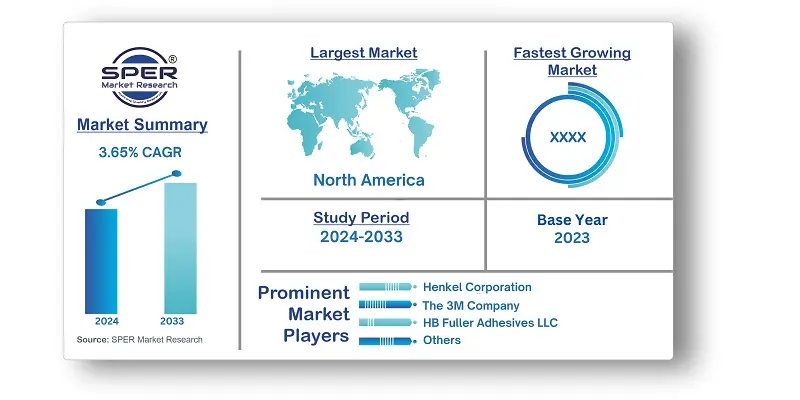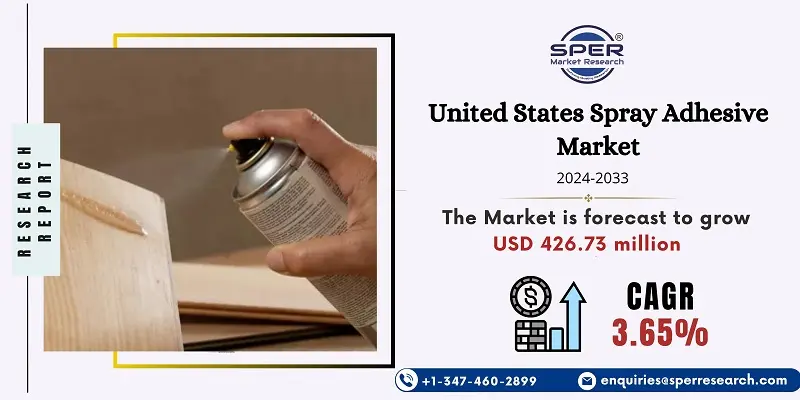
United States Spray Adhesive Market Growth, Size, Trends, Demand, Revenue and Future Outlook
United States Spray Adhesive Market Size- By Chemistry, By End User- Regional Outlook, Competitive Strategies and Segment Forecast to 2033
| Published: May-2024 | Report ID: CHEM2455 | Pages: 1 - 105 | Formats*: |
| Category : Chemical & Materials | |||
- In February 2021, Henkel Corporation, a prominent manufacturer of adhesive technology, and FREEDM Systems Engineering Research Centre announced an intriguing new collaboration. This collaboration aims to explore thoroughly into the topic of materials technology and its significant impact on power electronics applications. By doing thorough study and analysis, the two groups hope to uncover breakthrough solutions that will alter the sector.


| Report Metric | Details |
| Market size available for years | 2020-2033 |
| Base year considered | 2023 |
| Forecast period | 2024-2033 |
| Segments covered | By Chemistry, By End User |
| Regions covered | West United States, East United States, North United States, South United States |
| Companies Covered | Henkel Corporation, The 3M Company, HB Fuller Adhesives LLC, Avery Dennison Corporation, BASF Corporation. |
- Aquaculture Farmers
- Aquaculture Feed Distributors
- Aquaculture Researchers and Scientists
- Feed Manufacturers
- Government and Regulatory Bodies
- Investors and Financial Institutions
- Pet Food Manufacturers
- Research and Development Institutions
- Retailers and Wholesalers
- Veterinarians and Nutritionists
| By Chemistry: |
|
| By End User: |
|
- United States Spray Adhesive Market Size (FY’2024-FY’2033)
- Overview of United States Spray Adhesive Market
- Segmentation of United States Spray Adhesive Market By Chemistry (Epoxy, Polyurethane, Synthetic Rubber, Vinyl Acetate Ethylene, Others)
- Segmentation of United States Spray Adhesive Market By End User (Transportation, Construction, Furniture, Packaging, Textile)
- Statistical Snap of United States Spray Adhesive Market
- Expansion Analysis of United States Spray Adhesive Market
- Problems and Obstacles in United States Spray Adhesive Market
- Competitive Landscape in the United States Spray Adhesive Market
- Impact of COVID-19 and Demonetization on United States Spray Adhesive Market
- Details on Current Investment in United States Spray Adhesive Market
- Competitive Analysis of United States Spray Adhesive Market
- Prominent Players in the United States Spray Adhesive Market
- SWOT Analysis of United States Spray Adhesive Market
- United States Spray Adhesive Market Future Outlook and Projections (FY’2024-FY’2033)
- Recommendations from Analyst
1.1. Scope of the report1.2. Market segment analysis
2.1. Research data source2.1.1. Secondary Data2.1.2. Primary Data2.1.3. SPER’s internal database2.1.4. Premium insight from KOL’s2.2. Market size estimation2.2.1. Top-down and Bottom-up approach
2.3. Data triangulation
4.1. Driver, Restraint, Opportunity and Challenges analysis4.1.1. Drivers4.1.2. Restraints4.1.3. Opportunities4.1.4. Challenges4.2. COVID-19 Impacts of the United States Spray Adhesive Market.
5.1. SWOT Analysis5.1.1. Strengths5.1.2. Weaknesses5.1.3. Opportunities5.1.4. Threats5.2. PESTEL Analysis5.2.1. Political Landscape5.2.2. Economic Landscape5.2.3. Social Landscape5.2.4. Technological Landscape5.2.5. Environmental Landscape5.2.6. Legal Landscape5.3. PORTER’s Five Forces5.3.1. Bargaining power of suppliers5.3.2. Bargaining power of buyers5.3.3. Threat of Substitute5.3.4. Threat of new entrant5.3.5. Competitive rivalry5.4. Heat Map Analysis
6.1. United States Spray Adhesive Market Manufacturing Base Distribution, Sales Area, Product Type6.2. Mergers & Acquisitions, Partnerships, Product Launch, and Collaboration in United States Spray Adhesive Market
7.1. United States Spray Adhesive Market Size, Share and Forecast, By Chemistry, 2020-20267.2. United States Spray Adhesive Market Size, Share and Forecast, By Chemistry, 2027-20337.3. Epoxy7.4. Polyurethane7.5. Synthetic Rubber7.6. Vinyl Acetate Ethylene7.7. Others
8.1. United States Spray Adhesive Market Size, Share and Forecast, By End User, 2020-20268.2. United States Spray Adhesive Market Size, Share and Forecast, By End User, 2027-20338.3. Transportation8.4. Construction8.5. Furniture8.6. Packaging8.7. Textile8.8. Other
9.1. United States Spray Adhesive Market Size and Market Share
10.1. United States Spray Adhesive Market Size and Market Share By Region (2020-2026)10.2. United States Spray Adhesive Market Size and Market Share By Region (2027-2033)10.3. West United States10.4. East United States10.5. North United States10.6. South United States
11.1. Henkel Corporation11.1.1. Company details11.1.2. Financial outlook11.1.3. Product summary11.1.4. Recent developments11.2. The 3M Company11.2.1. Company details11.2.2. Financial outlook11.2.3. Product summary11.2.4. Recent developments11.3. HB Fuller Adhesives LLC11.3.1. Company details11.3.2. Financial outlook11.3.3. Product summary11.3.4. Recent developments11.4. Avery Dennison Corporation11.4.1. Company details11.4.2. Financial outlook11.4.3. Product summary11.4.4. Recent developments11.5. BASF Corporation11.5.1. Company details11.5.2. Financial outlook11.5.3. Product summary11.5.4. Recent developments11.6. Others
SPER Market Research’s methodology uses great emphasis on primary research to ensure that the market intelligence insights are up to date, reliable and accurate. Primary interviews are done with players involved in each phase of a supply chain to analyze the market forecasting. The secondary research method is used to help you fully understand how the future markets and the spending patterns look likes.
The report is based on in-depth qualitative and quantitative analysis of the Product Market. The quantitative analysis involves the application of various projection and sampling techniques. The qualitative analysis involves primary interviews, surveys, and vendor briefings. The data gathered as a result of these processes are validated through experts opinion. Our research methodology entails an ideal mixture of primary and secondary initiatives.



Frequently Asked Questions About This Report
PLACE AN ORDER
Year End Discount
Sample Report
Pre-Purchase Inquiry
NEED CUSTOMIZATION?
Request CustomizationCALL OR EMAIL US
100% Secure Payment






Related Reports
Our Global Clients
Our data-driven insights have influenced the strategy of 200+ reputed companies across the globe.




















